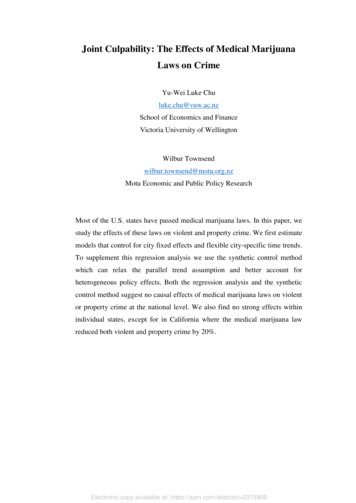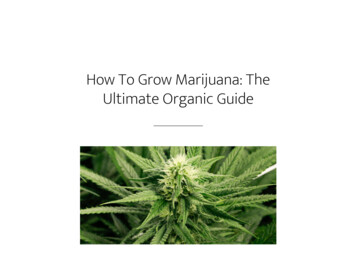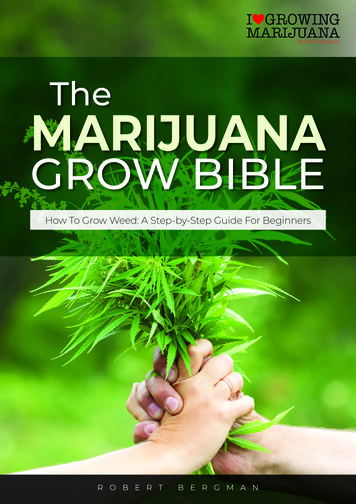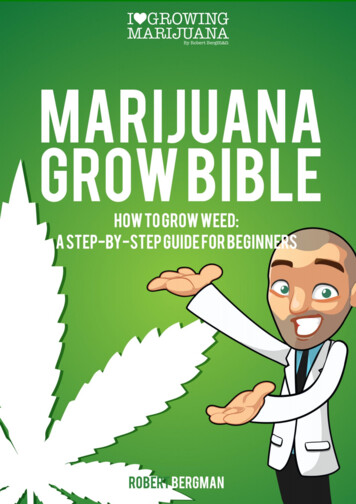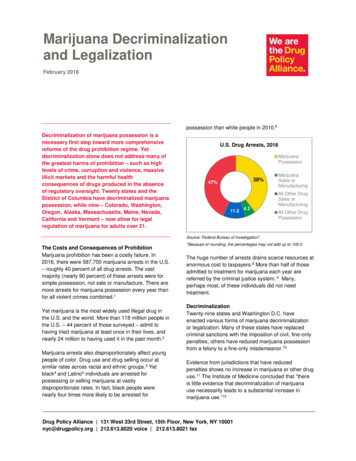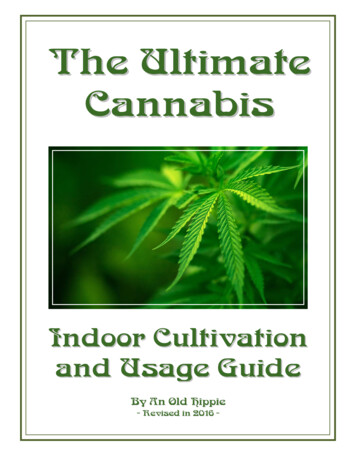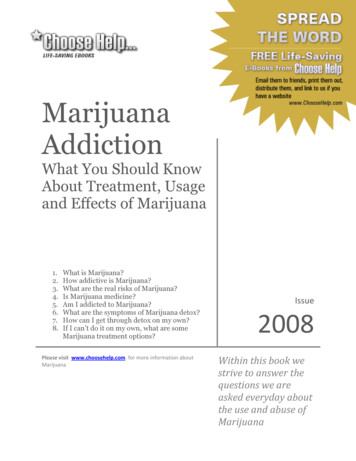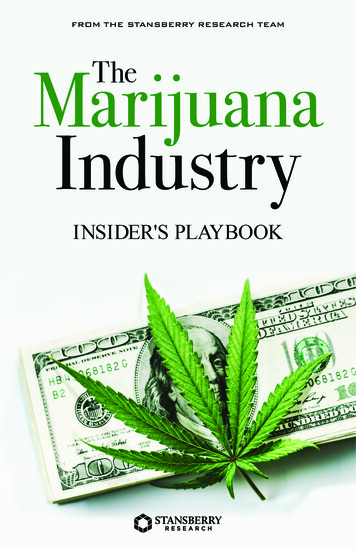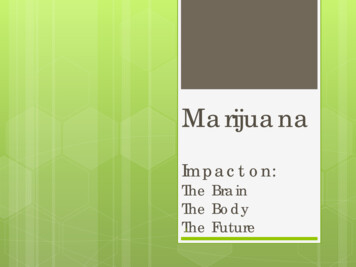
Transcription
MarijuanaImpact on:The BrainThe BodyThe Future1
2Learning ObjectivesIncrease knowledge of the effectsof marijuana in the areas of: ImpairmentHealthFuture SuccessAddictionPerception of Harm
Marijuana:The Basics3
4Marijuana BasicsCommon Forms Marijuana is a green, brown, or gray mixtureof dried, shredded leaves, stems, seeds, andflowers of the cannabis plant.Marijuana contains more than 400 chemicals.Buds have higher THC* content (the mainactive chemical in – main psychoactive – mind altering chemical in
5Marijuana BasicsCommon Forms
6Marijuana BasicsCommon Forms Hashish’ (or ‘hash’) is the pure resin separatedand collected from the flowering tops of thecannabis plant.Depending on purity it varies in color fromgolden brown to black. It can be smoked,eaten or vaporized.Hashish oil is produced by removing thecannabinoids from the plant material with aliquid.In the U.S., marijuana, hashish and hashish oilare Schedule I controlled substances.
7Marijuana BasicsCommon FormsMarinol is a Schedule III controlled substance thathas the active chemical CBD* and comes in pill form.Marinol is obtained through a prescription.*Cannabidiol – The second main ingredient in cannabis used widely for medicalpurposes.
8Marijuana Basics Marijuana is usually smoked as a cigarette (‘joint’), acigar (‘blunt’), or through a water pipe or bong. Marijuana can also be orally ingested. (Baked into food,boiled in water to make tea, or pill form in the case ofMarinol.) Marijuana can be heated with a liquid until the activeingredients turn to vapor which can be inhaled. Can be laced with or combined with other drugs suchas PCP.
9Slang/Street Names PotGanjaHerbWeedMary JaneGrassChronicKif ReeferSkunkBoomGangsterAnd more than 200othersDifferent strains ofmarijuana have theirown “brand” names
10Marijuana BasicsCommon effects include: ParanoiaShort term memory lossRelaxationHeightened sensory perception (brighter colors)LaughterAltered perception of timeIncreased appetiteEuphoria
11Marijuana Basics Over 111 million Americans havetried it at least once.An estimated 2.4 million Americansused it for the first time in 2012.2012 National Survey on Drug Use and Health, SAMHSA, 2013
12Marijuana Basics The FDA does not get involved to ensure safety ofmarijuana due to marijuana being federally illegal. Marijuana is not inspected or certified, making it impossibleto assess its safety for ingestion. Chemicals such as insecticides and pesticides may beapplied to marijuana plants to enhance the growingprocess.Marijuana can sometimes be laced with other drugsand/or substances(such as bath salts/cocaine)making theuse of marijuana much more dangerous.
13Marijuana Basics K2 or spice a synthetic cannabinoid.Does not come from the cannabis plant.Mixture of herbs and spices sprayed witha synthetic compound chemically similarto THC.Dangerous because toxicity of thecomponents can vary and be unknown.It is smoked or added to food and drinks.
14New drug under FDAInvestigation Sativex – contains both THC and CBD (nonpsychoactive).FDA is investigating drug as an analgesictreatment for patients with advanced cancerwhose pain cannot be controlled with FDAapproved opioids.Product not available for purchase in U.S. andused only for FDA approved clinical trials.
15New Trends - Dabbing Hash oilBudderHoney OilWax or Ear WaxSmoked in oil rig1 dab 5 joints*
16New Trends: Wax Made by removing the THC from the marijuanaby using butane which is highly flammable.Similar methods are used in the production ofmethamphetamine, cocaine and crack.Wax may contain 70% to 90% of THC. Users mayhave a high that lasts up to 24 hours.Wax is legal in CO, for anyone over the age of21 and can be bought in recreationalmarijuana dispensaries.
17New Trends -Vaporizers Teens have discovered the “G-Pen”which is used for medical marijuana.Gives the appearance of a pen orelectronic cigarette.Does not produce smoke or anyodor.
Marijuana:Impairment18
19ImpairmentEffects of marijuana vary as a result of: Individual physical characteristicsmetabolism/weight/ageDose (quantity and frequency)Route of administrationExperience of userOther substance use
20Marijuana, the Brain, and Impairment The human brain is not fully developed until age 25. The teen brain is more vulnerable to the negative effects ofmarijuana use. THC affects the (cannabinoid receptors) parts of the brain thatinfluence pleasure, memory, thinking, sensory, timeperception, coordinated movement and concentration. A“high” is produced when these parts of the brain areoverstimulated.The effects of being high creates: Memory problems Problems with processing information Poor sensory & time perception Poor concentration & coordinationSource: NIDA Research Report Series: Marijuana Abuse (rev. July 2012)
21Lasting impairment after use can result in difficultywith: Complex tasks Learning new skills Alertness and attention Ability to recall information Decision makingImpairmentWhen using, impaired decision-making can result in: Risky sexual behavior – STD’s, HIV andunintended pregnancy Increased risk of exposure to other substancesSource: Jacobus, J, Bava, S. et. al. (2009) Functional Consequences of Marijuana Use inAdolescence. Pharmacology, Biochemistry and Behavior 92(4).
22Impairment: CoordinationTHC disrupts coordination and balance by bindingto receptors in the part of the brain that regulatesbalance, posture, coordination, and reaction time.Therefore learning and doing complicated tasks,like driving and participating in athletics, areaffected.
23Impairment: Driving Teens are at a high risk of being involved in vehicle accidents.When combined with their lack of experience, being underthe influence of marijuana increases this risk even further.Studies found that driving ability became impaired aftermarijuana use.Drivers under the influence of marijuana have shorterattention spans and reduced reaction times.Driving while or after smoking marijuana is illegal.Source: Asbridge, M & Hayden, JA (2012) Acute cannabis consumption and motor vehicle collision risk:systematic review of observational studies and meta-analysis. British Medical Journal , 344:e536
24Impairment: Driving(1 of 2)Since 2000, Liberty Mutual Insurance andStudents Against Destructive Decisions(SADD) has been conducting a study ofteens driving under the influence. Data fromthe most recent report, released in February2012 shows: Nearly 1 in 5 teens have gotten behind thewheel after smoking marijuana.
25Impairment: Driving(2 of 2) Driving under the influence of marijuana (19%) is agreater threat than driving under the influence ofalcohol (13%). Study findings show that teens don’tconsider marijuana use a distraction to their driving. Study also found that most teen drivers would not drivewhile under the influence if asked by their passengersnot to. However, teen passengers are less concernedabout riding in a car with a driver who has smokedmarijuana than one who has used alcohol. Source: “Hazy Logic: Liberty Mutual Insurance/SADD Study Findings Driving Under theInfluence of Marijuana a Greater Threat to Teen Drivers than Alcohol.” Liberty MutualPress Release. February 22, %20Teen%20Release.pdf
26
27Impairment: Memory Marijuana use impairs a person's ability to form newmemories and to shift focus.Memory impairment from marijuana use occursbecause THC alters how information is processed.Adolescents who used marijuana regularly: Had compromised processing abilities when learning newinformationHad difficulty with retaining new memoryMade more errors on testsHad more difficulty paying attentionSource: Jacobus, J, Bava, S. et. al. (2009) Functional Consequences of Marijuana Use in Adolescence .Pharmacology, Biochemistry and Behavior 92(4).
Health:Marijuana’sEffects on theBrain and Body28
29Health: Effects on the BrainRecreational doses* may cause:DisorientationAltered time/space perceptionPanic reactionsEuphoriaPoor ConcentrationParanoiaSedationImpaired learning/memoryDrowsinessRelaxed InhibitionsAltered thought formationMore vivid senses*Recreational dose: used without medical justificationfor its effects often in the belief that occasional use ofsuch a substance is not habit-forming or addictive. Theonly medical justification of marijuana by the FDA is inthe form of tional%20drug)
30Health: Effects on the BrainFrequent doses may cause: Intensified reactionsFluctuating emotionsFragmentary thoughts withdisassociations Dulling of attentionImage distortionAcute psychosis* (includinghallucinations, delusions, and alost sense of personal identity)Symptoms occur more frequently when a high dose ofcannabis is consumed in food or drink rather than smoked.*Short-term psychotic reactions to high concentrations of THC aredistinct from longer-lasting, schizophrenia-like disorders that havebeen associated with the use of cannabis in vulnerable individuals."Marijuana Abuse." National Institute on Drug Abuse. National Institute on Health, July 2012. Web. 13 Sept. 2013. earch%20Reports .
Mean (age) Years of Onset of Psychosis byDegree of Exposure to Cannabis35302531.431.129.526.525.220151050Never used Hash atHashSkunk atSkunkcannabis week ends everyday week ends everdayor lessor lessSource: M. Di Forti et al. (2013). Daily Use, Especially of High-PotencyCannabis, Drives the Earlier Onset of Psychosis in Cannabis Users.Schizophrenia Bulletin.
32Health: Effects on the BrainOver time, regular exposure to THC can permanentlyalter how the brain works, even if the drug is notcurrently being used.ControlMarijuana AbuserSource: Volkow et al., Psychiatry Research: Neuroimaging, 67, pp. 29-38 (1996). This slide is from: Volkow,ND (2011) Marijuana’s Effects on Brain, Body and Behavior. Presentation March 8, /03/volkow-marijuana-presentation.pdf
33Health: Effects on the BodyMarijuana use can cause teens to overestimate theirabilities & impair good judgment resulting in riskybehaviors such as: Unplanned and/or unprotected sex Dangerous stunts/actions Operating a car, ATV, snowmobile, boat, bikewhile under the influence
34Health: Effects on the BodyMarijuana can cause the heart rate toincrease by 20 to 50 beats per minute. Thisincrease can last for hours after use hasstopped.Increased heart rates can be even greater ifother drugs are used at the same time.Source: Mittleman MA, Lewis RA, Maclure M et al. (2001) Triggering myocardial infarction by marijuana.Circulation, 103(23) 2805–2809.
35Health: Effects on the BodyResearchers found that marijuana userswith pre-existing conditions have anincreased risk for a heart attackcompared to the general risk of heartattack when not smoking.Source: Mittleman MA, Lewis RA, Maclure M et al. (2001) Triggering myocardial infarction bymarijuana. Circulation, 103(23) 2805–2809.
36Health: Effects on the BodyThe amount of tar inhaled by marijuana smokersand the level of carbon monoxide absorbed arethree to five times greater than from tobaccosmoke.Drugs and Human Performance Fact Sheets - Cannabis / Marijuana. National Highway Traffic SafetyAdministration, n.d. Accessed at: drugs/cannabis.htm .Marijuana contains more cancer causing chemicalsthan tobacco. Marijuana smokers inhale deeplyand hold the smoke in their lungs longer which mayincrease their risk for developing lung cancer.The British Lung Foundation (2012) The Impact of Cannabis on Your Lungs. Accessed ngs---BLF-report-2012.pdf
37Health: Effects on the Body The California’s Office of EnvironmentalHealth Hazard Assessment placedmarijuana smoke on its official list ofknown carcinogens in 2009.Tomar, R. S., Beaumont, J., & Hsieh, J. C. Y. (2009). Evidence on the Carcinogenicity ofMarijuana Smoke. California Environmental Protection Agency. Reproductiveand Cancer Hazard Assessment Branch, Office of Environmental Health HazardAssessment.
38Health: Effects on the BodyRecent studies haveshown a link betweenfrequent marijuana useand the occurrence oftesticular cancer.Lacson, J., Carroll, J., Tuazon, E., Castelao, E., Bernstein, L., & Cortessis, V. (2012). Population –based case-control study of recreational drug use and testis cancer risk confirms anassociation between marijuana use and nonseminoma risk. Cancer, 118(21) 5374-5383.
39Did you know marijuana use caninterfere with the safety and/orissues?effectivenessof medicines peopletake to treat health problems?Marijuana use can interfere with medicineprescribed by a ugs.aspx
40Impact on the Family For parents who use marijuana, their ability toparent may be impacted by “difficulty pickingup on their babies’ cues because marijuanadulls response time and alters perceptions.”“When parents repeatedly miss their babies’cues, the babies eventually stop providingthem which results in disengaged parents withdisengaged babies.”Source: Protecting Children in Families Affected by Substance Use Disorders: Child Abuseand Neglect User Manuel Series,” U.S. Department of Health and Human ServicesAdministration for Children and Families, Administration on Children, Youth and FamiliesChildren’s Bureau, Office on Child Abuse and Neglect, 2009.
41Impact on the Family Some parents may choose to grow marijuana in theirhome or live in a marijuana growing operation which hasnegative impacts on children’s health: Mold exposure Possible electric shock Exposure to high levels of carbon monoxide Explosion risks Bobby traps and weapons Potential eye damage from ultraviolet lights Exposure to dangerous chemicals used in the growingprocessSource: “Capital Health, Edmonton Area: Public Health Division, Environmental Public Health ServicesFact Sheet.”
42Unintentional PediatricMarijuana Exposures 985 calls to US poison centers in children ages9 and younger between 2005 and 2011.Rate of calls in states that passed legislationlegalizing marijuana use (recreational ormedicinal purposes) before 2005 increasedfrom 3.9 calls per 100,000 population in 2005 to14.8 calls per 100,000 population in 2011.Source: CESAR Fax March 3, 2014.Vol. 23, Issue 8
43Unintentional PediatricMarijuana Exposures Rate of calls in transitional states (enactedlegislation to legalize marijuana) between 2005and 2011 increased from 5.2 calls per 100,000population to 8.7 calls per 100,000 population.Rate of calls in states that did not passlegislation saw no change in the rate of poisoncenter calls.Source: CESAR Fax March 3, 2014.Vol. 23, Issue 8
44Unintentional PediatricMarijuana Exposures “Increased call rate may be caused by increasein: use by family memberslikelihood of ingestionpotency of ingestionlikelihood of caregivers calling poison centers orpresenting to health care facilities for help.”Need for “child-resistant packaging, warninglabels and public education, when draftingmarijuana legislation.”Source: CESAR Fax. March 3, 2014, Vol. 23, Issue 8.
45
FutureSuccess:Getting HighCan ReallyBring You Down46
47Future Success Teen marijuana use has negativeconsequences in the areas of education,skill training and job opportunities.Marijuana use among teens has been linkedto lower school performance and reducedjob prospects.Source: Jacobus, J, Bava, S. et. al. (2009) Functional Consequences of Marijuana Use in Adolescence .Pharmacology, Biochemistry and Behavior 92(4).
48Future Success:Impact on EducationResearch shows that teen marijuana use affects theireducation by: Lowering academic performance Increasing truancy & drop out Reducing likelihood of graduation Interfering with future goal setting or life planning Higher risk of future unemploymentSource: Jacobus, J, Bava, S. et. al. (2009) Functional Consequences of Marijuana Use inAdolescence . Pharmacology, Biochemistry and Behavior 92(4).
49Marijuana Use and School Drop Out Dropping out of high school is related to a number of negativesocioeconomic and health outcomes.One in seven 12th graders dropped out of high school and hadhigher rates of current substance use than similar aged peers whowere still in school.
50Future Success: Impact on EducationStudents who are cited for illegal druguse/possession while receiving studentfinancial aid may be at risk for losing theirfinancial aid and/or federal student loans.Source: U.S. Dept. of Education "Students with Criminal Convictions Have Limited Eligibility for FederalStudent Aid." Accessed Aug. 12, 2013 at: ctions#drug-convictions
51Future Success: Impact on EducationThose with a drug possession conviction may beasked to complete substance abuse treatment priorto acceptance to college or technical schools.Source: U.S. Dept. of Education "Students with Criminal Convictions Have Limited Eligibility for Federal StudentAid." Accessed Aug. 12, 2013 at: ictions#drug-convictions
52Future Success: Impact on EducationIn a study of college students, heavy marijuanausers: Made more errorsHad more problems paying attention tochanges in the environmentHad more problems learning than studentswho used less often or not at allSource: Harvey M.A, Sellman J.D., Porter R.J., Frampton C.M., (2007) The relationship between nonacute adolescent cannabis use and cognition. Drug and Alcohol Rev. 2007 Vol.6 309-19
53Marijuana and IQ Researchers in New Zealand conducted aprospective study with 1,037 individuals frombirth till age 38.IQ tests were administered at ages 13 and 38.Marijuana use was gathered in interviews atages 18, 21, 26, 32 and 38.IQ scores were compared as a function ofmarijuana use.Meier et al. (2012). Persistent Cannabis Users Show Neuropsychological Decline fromChildhood to Midlife. Proceedings of the National Academy of Science, vol. 109, no 40 (E2657 – E2664).
54Marijuana and IQ Study findings showed individuals who usedmarijuana heavily in their teens and continuedthrough adulthood had a drop in IQ betweenages 13 to 38.Average of 8 points for those who met a diagnosisof marijuana dependence.“Loss of 8 IQ points could drop a person ofaverage intelligence into the lowest third of theintelligence range.”Meier et al. (2012). Persistent Cannabis Users Show Neuropsychological Decline fromChildhood to Midlife. Proceedings of the National Academy of Science, vol. 109, no 40 (E2657 – E2664).
55Future Success: Impact on Employment Several studies have linked workers’ marijuana smokingwith: Increased absencesTardinessAccidentsWorkers’ compensation claimsJob turnoverIndividuals who tested positive for marijuana onpre-employment urine screens had: 55% more industrial accidents85% more injuries75% increase in absenteeism compared with those whotested negative for marijuana use.Source: NIDA Research Report Series: Marijuana Abuse (rev. July 2012)
56Future Success: Impact on IntimatePartner Violence Studies show that regular use of marijuanaby teens and young adults increases theirrisks of becoming victims or offenders ofintimate partner violence.Source: Reingle, J. et al. (2012) The Relationship Between Marijuana Use andIntimate Partner Violence in a Nationally Representative Longitudinal Sample.Journal of Interpersonal Violence, 27(8): 1562-1578.
Cannabis Use and Later Life OutcomesAre Dose Dependent% welfare dependent(ages 21-25)% Unemployed(ages 21-25)mean personalincomein thousands of at age 25400 300 to 399200 to 299100 to 1991 to 99NeverNumber of occasions using#Cannabisof occasionsusingbetween ages14-21Cannabis ages 14-21% gained universitydegreeby age 25Source: Fergusson and Boden. Addiction, 103, pp. 969-976, 2008.
58Drug Testing and SyntheticCannabinoids Known as K2 or Spice.Usually not included in routine drug tests dueto the need for specialized expensive testing.Great variation between products so difficultywith identifying what metabolites should beincluded in testing.Source: CESAR Fax. July 8, 2013 Vol. 22, Issue 27.
59Drug Testing and SyntheticCannabinoids “Some synthetic cannabinoid users use thedrug as a substitute for marijuana to avoidpositive drug tests.”Most of the users returned to marijuana oncethe drug-testing period ended.Per a study participant “spice would give you aweed like effect without the positive test.”Source: CESAR Fax. July 8, 2013 Vol. 22,Issue 27.
MarijuanaandAddiction60
61Marijuana and AddictionAddiction: A state in which a person engages in a compulsivebehavior that may be reinforcing and initiallypleasurable.Loss of control when trying to limit intake.Continued use despite negative consequences.Dependence: A person physically and mentally needs a drug in orderfor their body to function normally. The body becomes dependent on a drug physicallyand psychologically. Stopping the use of the drug leads to physicalwithdrawal symptoms.
62Marijuana and AddictionSigns of Addiction: Experiencing difficulty controlling the urge to useUsing before school/work/other activitiesSeeking out others who useSpending time thinking about using/talking aboutusing/seeking out the drugContinued use despite the negative consequencesIt is suspected that the early use of marijuana by youthcoupled with a higher potency of the drug contributes togreater rates of addiction.Source: United Nations Office on Drugs and Crime (2012) Cannabis A Short Review: Discussion Paper
63Marijuana and AddictionThose who are addicted experience withdrawalsymptoms: IrritabilityAnxietyInsomnia or sleep disturbancesAppetite DisturbanceDepressionMost studies suggest that withdrawal symptoms start on the first dayof abstinence, and usually peak within the first 2 to 3 days of quitting,with the exception of sleep disturbance.Withdrawal symptoms are usually over after 2 weeks, but thisdepends on how dependent someone is on cannabis before tryingto quit.Source: National Cannabis Prevention & Information Centre. (2011) Cannabis Withdrawal: Factsheet 24. Accessed cannabiswithdrawal
64Marijuana and Addiction Marijuanadependence is the 3rd most commontype of drug dependence in many parts of theworld, including the U.S. and Canada. (Tobaccoand alcohol are 1st and 2nd) Source: United Nations Office on Drug and Crime. ND. Cannabis A Short Review 1in 6 who start using marijuana in their teensbecome addicted. Source: National Institute of Drug Abuse. Dec. a-19.htm Marijuanais the primary drug of abuse in 18 % ofU.S. treatment admissions. Source: Substance Abuse and Mental Health Services Administration, Center for Behavioral HealthStatistics and Quality. Treatment Episode Data Set (TEDS): 2000-2010. National Admissions toSubstance Abuse Treatment Services.
Marijuana:Perception of Harm65
66Marijuana: Then and Now Marijuana has become more potent over the years. The increase in marijuana potency means a smalleramount can induce a greater level of intoxication, makingit easier to get higher, faster. With legalization of medical marijuana, emphasis is ongrowing plants with higher THC content and the quickestway possible. This leads to a type of “Hybrid” plant which is more likely tobe abused.Source: Mehmedic Z, Chandra S, Slade D. et. al. (2010) Potency Trends of THC and OtherCannabinoids in Confiscated Cannabis Preparations from 1993-2008. Journal of ForensicSciences, 55(5) 1209-17.
67Marijuana: Then and Now
68Perception of Harm People often pose the rhetoricalquestion: “Has anyone ever diedfrom using marijuana?”The answer is YES, when it is causedby: Motor vehicle collisions Fatal accidents caused byimpaired judgment Marijuana laced with anotherdrug
69Marijuana and the Environment Illegal marijuana growers use chemicals, highamounts of energy and make changes to landstructure leaving lasting damage to oursurroundings.They also use poisons to keep animals fromdestroying their crops and equipment.Source: Gabriel MW, Woods LW, Poppenga R, Sweitzer RA, Thompson C, et al. (2012)Anticoagulant Rodenticides on our Public and Community Lands: Spatial Distribution ofExposure and Poisoning of a Rare Forest Carnivore. PLoS ONE 7(7): e40163
70Marijuana and the Environment The poison not only affects small animalsthat eat it but also larger animals that preyon them.Wildlife studies show that endangeredanimals are also being exposed and killedby these poisons.Source: Gabriel MW, Woods LW, Poppenga R, Sweitzer RA, Thompson C, et al. (2012) AnticoagulantRodenticides on our Public and Community Lands: Spatial Distribution of Exposure and Poisoning of a RareForest Carnivore. PLoS ONE 7(7): e40163
71Marijuana and the Environment August 2009 – LaBrea Wildfire: began inthe Los Padres National Forest within theSan Rafael Wilderness area in SantaBarbara County, CA and includedsurrounding county and private lands.Destroyed 89,000 acres of land.
72Marijuana and the Environment Per the US Forest Service, this fire was causedby an illegal cooking fire at the site of arecurring outdoor marijuana grow site.The grow site contained 20,000 marijuanaplants.Per the US Forest Service the fire cost 35million (putting it out and resource damage).
73Restoring Mother Nature Per the US Park Service it costs 14,900 to 17,700per acre to clean-up and restore landdamaged by illegal marijuana growing.Costs include removing and disposinghazardous waste, removing camp facilities,irrigation hoses and garbage, etc.Source: Marijuana Site Reclamation and Restoration Cost Analysis.” U.S. Department of Interior,National Park Service. December 9, 2010(unpublished data).
YouthMarijuana Usein the UnitedStates:A Look at theData74
75
76
77
78
MarijuanaUse inMaine:A Look at theData79
Youth and Young Adults One in five high school students reportedusing marijuana within the past month (MaineIntegrated Youth Health Survey , 2013). Similar rates are seen within the young adult (1825) population (Behavioral Risk Factors Surveillance System,2012).80
National Comparison36%of Maine residents between 18and 25 usedmarijuana in the past year in 2011-12 (NSDUH), this wascompared to the National average of31% In 2011-12, 11% of residents ages 26 had usedmarijuana in the past year, compared to 8% nationally .81
National Comparison About One in four (23%) Maine 18 to 25 year olds hadused marijuana in the past month (NSDUH, 2011-12).25%20%United StatesMaine15%10%5%0%12 to 1718 to 2526 and older Rates are expected to increase with the inception of medical marijuana.82
Initiation of Use In 2013, 73% of high school students who had everused marijuana first did so when they were between theages 13 and 16 (MIYHS).7% 8%12%10 or younger11 to 1213 to 1437%15 to 1636%17 or older One in Five tried marijuana for the first time before theage of13.83
Availability2013Very easy,35%Sort of easy,21%Sort of hard,15%Very hard,29% In 2011, over half (56%) of high schoolstudents felt it would be easy to Remained stable since 2009get (MIYHS).84
Availability students who thought marijuana was easy to obtainwereas likely to use marijuana (MIYHS, 2013).50%40%35%30%20%7%10%0%Easy to get, smoked MJpast 30 daysNot easy, smoked MJ past30 days85
Perception of Harm Students who thought smoking marijuana regularlywas risky decreased from 61% in 2009 to 48%100%in 2013 (MIYHS).80%60%61%56%40%Great risk27%No risk24%Moderaterisk21%Slight risk28%48%20%0%200920112013Believed Moderate toGreat Risk86
Perception of Harm High school students who think there is no risk to aslight risk in smoking marijuana regularly areas likely to smoke marijuana (MIYHS, 2013).50%40%38%30%20%5%10%0%Don't think risky, smokedMJ past 30 daysThink risky, smoked MJpast 30 days87
Perception of Harm12In the 2011-12,% ofadults ages 18 to 25perceived a great risk insmoking marijuana once permonth (NSDUH).50%40%30%34%32%30%27%26 Among adults aged,perceptions of risk havedecreased by 11 percentagepoints since 2006-07.20%10%26%23%14%15%15%13%12%12%0%18-25 year olds26 year olds88
Perception of EnforcementDefinitely not25%2013Probably not52%Definitely yes8%Probably yes15% In both 2013, 77% of high school students felt kids inthe community would not be caught by police forsmoking marijuana (MIYHS).89
Perception of Enforcement Students who did not think that they would be caughtby the police were more thanmarijuana.3x as likely to smoke26%8%No, caught by police, yessmoked MJ past 30 daysYes, caught by police, yessmoked MJ past 30 days90
Community and Social Norms In 2013, 39% of students thought they would beseen as “cool” if they smoked marijuana (MIYHS).Wrong17% In 2013, 15% ofA little bitwrong10%Very wrong68%Not wrongat all5%students reported thattheir parents wouldnot feel it wouldbe wrong for them tosmoke marijuana (MIYHS).91
Community and Social Norms High school students who believe their parentsdon’t feel it is wrong for them to smoke marijuanawere4xas likely to use (MIYHS, 2011).61%15%Yes, my parents think it's wrong, yesNo, my parents don't think it'ssmoked MJ past 30 dayswrong, yes I smoked past 30 days92
Community and Social NormsVery wrong,Not wrong at47%all, 7%A little bitwrong, 16%Wrong, 31% Almost one in four students thought that adultsin their community would not feel it would be wrong tosmoke marijuana (MIYHS, 201
Marijuana is a green, brown, or gray mixture of dried, shredded leaves, stems, seeds, and flowers of the cannabis plant. Marijuana contains more than 400 chemicals. Buds have higher THC* content (the main active chemical in marijuana.) * Delta-9-Tetrahydrocannabinol – main psychoactive
